At any rate, it was good for me to see
Now the more fun part. The hotel rooms in 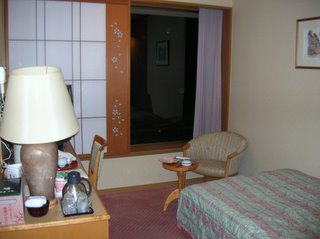
Although I did get a bigger room later on. It wasn’t much bigger.
To be fair, I did get a much larger room the next night when I got a tatami room. It was kinda neat.
Imagine a 10’x15’ room that is just floor space, except instead of wood or carpet, it’s all tatami. (The bathroom was outside this tatami-floored room, between the door to the hotel room and the tatami room) When I arrived in the afternoon, there was simply a very short table in the middle of the room. The table is less than half the height of a normal table, since you sit cross-legged instead of on a chair. On the table, there was the typical hotel room accommodation: tea kettle, cups, tea, and a little bit of sweets.
After returning from dinner, the room was made up. The table was pushed to one corner, and the “bed” was moved to the center of the room. A very simple mattress pad (don’t be expectin’ pocketed coil springs), a pillow, and a comforter was setup.
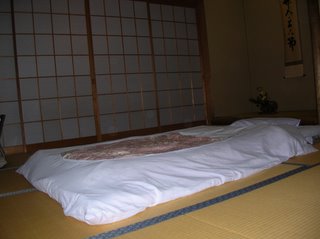
I have seen many tatami rooms in my life, growing up in
The best part of staying at these hotels was that they were all had their own hot spring and every night, we would go sit in these steaming pools and relax. I must say, the best pools were those outside. A light breeze and steaming hot spring really did it for me. I was told that although traditionally hot spring pools were co-ed, modern
On to this one dinner we had. The food was not the best (what do you expect when you are with a tour group), and the dinning room was just a big room with tatami. Everyone had a little miniature table filled with various kinds of
The first night we got there, we were taken to a Geisha show. I would like to say that I really enjoyed it, but I just couldn’t understand the music and the dance. It’s like watching cricket, players look kinda nice in sweaters, but I have no appreciation of the game since I have no idea what is going on (and how on earth a match could go on for days). But Geisha show was an eye opener that was also enjoyable.
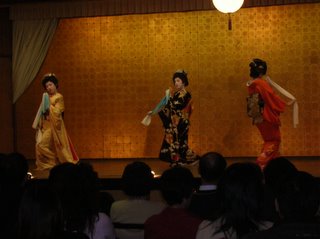
A nice, old styled “taxi” that was popular in
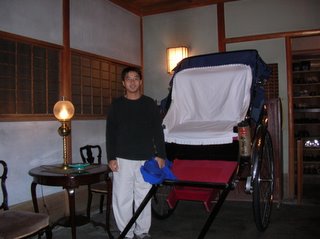
We also went to a couple Japanese Buddhist temples. They were really nicely built.
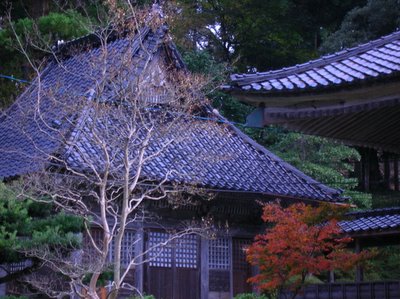
Here is one noteworthy building. The roof is completely made out of straw. They stack on the straw layer after layer. However, the straw alone isn’t enough to keep the rain out. So, they would use the house part time in the winter, heating it up with firewood inside. Supposedly, the smoke would then fill the holes in between straw. A big roof can take up to 20 years to “fill” before it is ready to use. These roofs also have to be replaced every fee decades. There is a U.N. designated world history site somewhere in
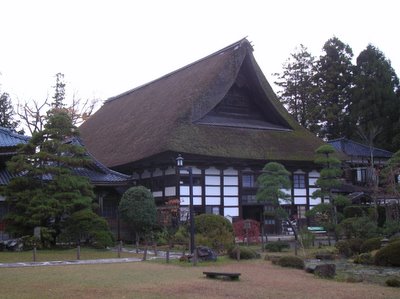
I was told that these houses, while really cool in concept and look, are actually pretty cold in the winter and hot in the summer. I am not sure if it’s because the heat wasn’t on or the fire wasn’t burning when we went to visit, it was just as cold inside.
Anyway, there is another typical Japanese building here. For some reason, one temple is usually a collection of buildings. I guess this is not strange, I am just too used to the Chinese and European style religious sites: one cathedral, one temple.
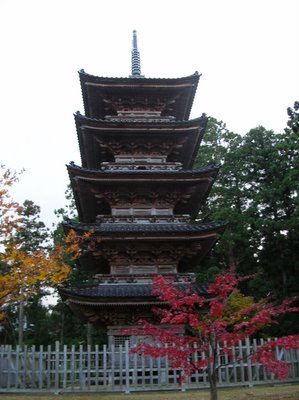
There was also a flower show at one of the temples. The mums on display were truly different, if not outstanding.

I think this one actually won some competition.

You probably can’t tell from the picture, but the leaves are actually not pointy. They are just like regular mums in the
No comments:
Post a Comment